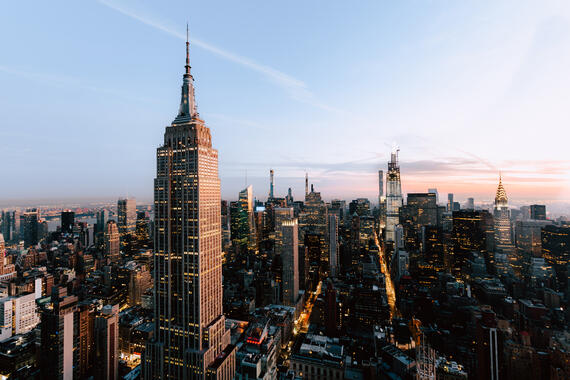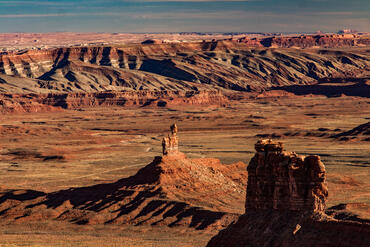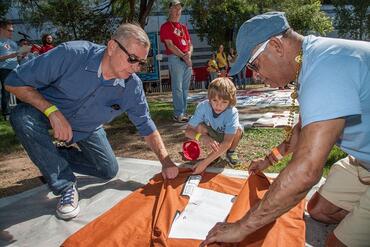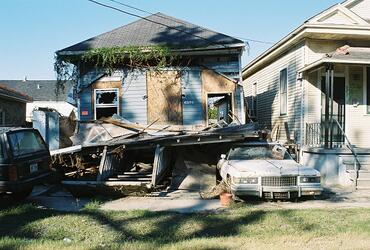A Focus on the US

While we are fundamentally a global organization, New York City is our home base. We have long been headquartered in the Empire State Building— a world monument in its own right — and it is striking to see the once-bustling streets around our offices now quiet, as the city grapples with the COVID-19 pandemic.
Colonel James Gray, who founded WMF in 1965, instilled some very American values in our DNA: a sense of adventure, a can-do-anything attitude, and a will to do good in the world. It is this same spirit we are seeing play out at the local level across the United States during this challenging time.
We dedicate this newsletter, which usually recounts stories spanning the globe, to events closer to home.
I hope this newsletter finds you well and that you and your families are staying safe and sound. We wish you a good holiday weekend despite the circumstances and we thank you for your continued friendship and support.

Bears Ears National Monument

Bears Ears National Monument urges visitors to stay home
Since late 2019, we have partnered with Friends of Cedar Mesa and local indigenous communities to advocate for the continued protection of the sacred Native American lands that make up a large part of Utah’s Bears Ears National Monument—a 2020 World Monuments Watch site.
An unprecedented situation emerged when the officials of the Southeast Utah Health Department decided to close hotels and campgrounds to visitors in Moab, the nearby gateway to Arches and other popular National Parks. People who had been camping there came to Bears Ears instead of following the guidance to return home, putting themselves and the local population at risk in an area with scarce medical facilities. This forced the San Juan County Health Department to close camping at Bears Ears to non-county residents.
While striking, this challenge is not isolated to Bears Ears. The U.S. National Park Service has seen a rise in tourism overall, which we would normally celebrate if not for the greater risk to visitors, park staff and local communities. For more on this issue, our partner’s opinion piece in the Salt Lake Tribune is a must-read.

The 1918 pandemic: monuments and memory
The clear analogy to what we’re experiencing today is 1918’s influenza pandemic. It is estimated that the pandemic killed up to 50 million people worldwide — far more than died as a result of the First World War.
Despite the enormous impact, and in stark contrast to markers of the nation’s wars or pandemics such as AIDS, it is difficult to find monuments and memorials to the 1918 pandemic. As The New York Times recently speculated on this dearth of memorials, it may be due to the 1918 flu being “too painful, perhaps. Best forgotten.” A recent op-ed by Times columnist David Brooks explores why there may be an inclination to forget rather than memorialize, raising questions about how society deals with traumatic histories.
As we find ourselves once again in the midst of a global pandemic, it is interesting to reflect on how we have chosen to commemorate similar events of the past. And, while still far too early to fully comprehend the scale and ultimate character of the novel coronavirus crisis, we can’t help but wonder how we might commemorate what we are all experiencing right now.
We have no idea what, if anything, will ultimately be constructed. But it is interesting to note that a crowdsourced COVID Memorial has already been established as a place to share remembrances of loved ones lost to COVID-19, and to encourage public health measures.

From WMF's visit to the Gulf Coast, 2005

From the Archives: Heritage in times of crisis — Hurricane Katrina
WMF was born out of crisis, with our first major initiative in response to the catastrophic flooding in Venice in 1966. Since then, we have continued to answer the call around the world, from earthquakes in Japan, Mexico and Haiti to post-conflict reconstruction in the Middle East.
In the United States, we swung into action when Hurricane Katrina hit the Gulf Coast, destroying more than 60,000 buildings in Mississippi alone. Of these, as many as 1,000 were National Register landmarks. One month later, WMF partnered with the National Trust for Historic Preservation, the Preservation Trades Network, and the University of Florida College of Design, Construction, and Planning to launch a program to assist historic districts affected by the storm.
The objective was clear: to present alternatives to widespread demolition along the Gulf Coast by supporting model restoration projects of building types common to the area. Drawing upon national and international precedents, we developed restoration and treatment guidelines, and distributed them to historic property owners, private groups, and public agencies; design guidelines that elucidated respect for historic typologies, scale, and materials were emphasized. Finally, the program initiated a series of strategic intervention grants targeting sites in need of immediate stabilization and conservation measures to prevent their loss. More information about this important work is available here.
Today, our Crisis Response Fund ensures we remain ready to deploy immediate assistance when crisis strikes — wherever it is in the world. In such challenging times, heritage can play an important role in rallying communities around shared values and providing economic opportunities to people most directly impacted.
